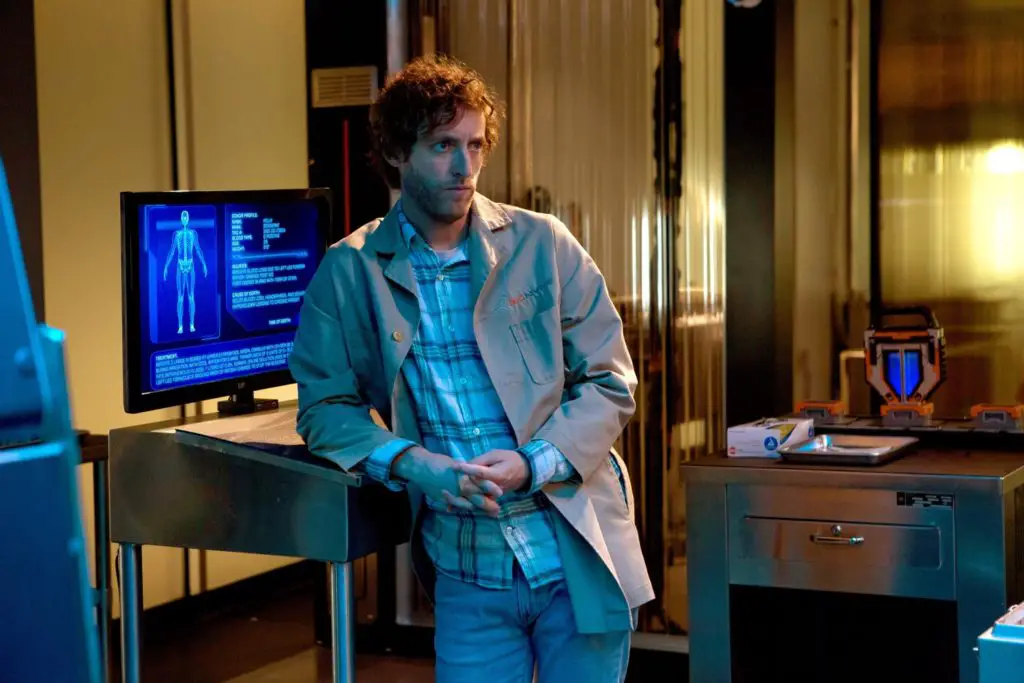Digital Frankenstein: what’s wrong with the film “Replicas” with Keanu Reeves. Plot summary, meaning of the film, explanation of the ending.
Country: USA
Genre: fantasy, thriller
Year of production: 2018
Directed by: Jeffrey Nachmanoff
Actors: Keanu Reeves, Alice Eve, Thomas Middleditch
tagline: “He did it”
On the one hand, the picture of Jeffrey Nachmanoff is called ambitious and well-developed, on the other hand, it is strange and raw. The meaning of the film Replicas is quite debatable. Nevertheless, the plot of this tape makes you think about many things – in particular, about what makes a person human and about what we can one day come to if, in the pursuit of technological progress, we completely forget about something more important.
What is the movie about
Brief description of the content of the film Replicas. The protagonist of the film, scientist Will Foster (Keanu Reeves), is working on digitizing the consciousness of dead people. The meaning of his work is to clone, “revive” them in this way.
 Will Foster is played by Keanu Reeves. Frame from the film.
Will Foster is played by Keanu Reeves. Frame from the film.
Another experiment fails and the authorities threaten Foster with dismissal. He defends himself, assuring that the next robot has already begun to speak, which means that a breakthrough is not far off. However, how much he himself believes in this is unknown.
One day, a tragedy occurs: the car in which Foster was traveling with his family gets into an accident. Will himself survives, but his wife and three children, Sophie, Matt and Zoe, die. From now on, he becomes obsessed with the idea of returning the family by transplanting their consciousness into robots. But not everything is so simple.
The main problem with a consciousness transplant is that it understands that it is not in its body. However, the hero Keanu Reeves is not embarrassed and does not stop. Absorbed by the idea of a fix, he forgets about what he previously talked about with his wife. In particular, she asked him to never “cross the line” and he made her a promise. However, everything collapsed after she died. Now he is sure that he has the right to “cross the line” and believes that this time he will succeed.
The scientist places the grown robots in special containers. It is assumed that if everything goes as it should, then in 17 days Will will be reunited with his wife and children. After 5 days, familiar families begin to sound the alarm. However, Foster manages to create the illusion that everything is in order.
Eventually the Foster family wakes up. The scientist himself understands that the experiment seems to have been a success. Except that his youngest daughter, Sophie, begins to suffer from nightmares about a recent accident. Foster tries to erase her memory, but his wife finds him doing this. He has no choice but to confess what he did.
Gradually, family life is getting better and Foster’s wife Mona seems to get used to the fact that she is a reproduction. However, Will’s boss, Jones, soon comes to visit the Fosters. He categorically assures that the reproductions must be destroyed, because the clone project itself was not originally intended to achieve medical goals. Foster continues to be perplexed and then the authorities discourage him even more. The answer lies in the fact that this “mission” itself was funded by the American government, because the main goal was the development of bionic weapons. If the clones are left to live, sooner or later everyone will find out about the project, and this is unprofitable for the special services.
After a terrible conversation with the authorities, the main character realizes that from now on his life has acquired a new meaning: he needs to save his family at all costs…
Replicas Ending explanation
Explanation of the ending of the picture. Near the end, Jones’ mercenaries kidnap Foster’s family. He frees them and sends them to a remote island. He himself remains in the laboratory and under pressure from Jones, who by this time realized that cloning people can make a lot of money, the project continues.
A little later, Foster manages to upload an imprint of his mind into the body of a clone and agree with his superiors on the following: Jones can do with the project and fees as he sees fit, and in return let him promise that he will leave Will himself and his family alone. Jones agrees to this, and the scientist finally connects with dear people.
The meaning of the ending of the film Replicas is considered by many viewers to be very ambiguous. The thing is that initially the creators of the picture spoke almost in plain text about the inadmissibility of human cloning. However, the finale completely crosses out the previously stated “message”.
Some viewers who have analyzed the tape offer a rather gloomy interpretation of the final scene. It seems that we are gradually accustomed to the fact that a person without a soul can very well exist.
That is, if earlier we were told that a soulless person is a monster (in every sense of the word), now the agenda has changed: long live the cloned future with smiling and happy “as if people”. It all looks very creepy. After all, without a soul, a person loses something very important. You can’t lose it, otherwise death will really be a terrible point of no return, but this idea has also been instilled in us for many years …
 Alice Eve as Mona, MJ Anthony as Matt Foster. Frame from the film.
Alice Eve as Mona, MJ Anthony as Matt Foster. Frame from the film.
The meaning of the film Replicas
Replicas is based on a science fiction story by Stephen Hamel. It, like the painting by Jeffrey Nachmanoff, does not have any hidden meaning, and he does not pretend to special depth, but it also touches on the extraordinary and complex topic of cloning and consciousness transfer.
In addition, the theme of Frankenstein of our days is interestingly revealed here. And the conditional “game of God” is shown in the Replicas very well. The film itself is more of a fantasy about how a dead person can be resurrected, relying solely on science and previously acquired knowledge.
The scale, frankly, is amazing: here we see the strength and power of the human intellect, which seems to create like its own kind (in fact, not) simply because it can do it. That is, the essence of the film lies in a simple and from this eerie message: science is able to prolong life, return it and neutralize death.
The topic is not new, but the creators of Replicas look at it from a slightly different angle. If earlier a person trying to give life to something that is dead or initially devoid of a soul did it purely for the sake of his ambitions, now we are presented with a touching story of a scientist who has lost his family and is trying to save it.
Desperate after the tragedy that happened to his loved ones, Foster forgets about ethical standards. For the sake of saving his loved ones, he is ready not only to cross the line, but also to do something else – for example, to take the lives of conditional “enemies”. Moreover, it cannot be said that the transformation of Foster from a modest scientist into an action hero is just a tribute to the genre, and at the same time an attempt to wink friendly at Keanu Reeves fans. It is possible, of course, that this is what was originally meant, but in the context of all events, Foster’s transformation looks scary. Like himself, he seems, to put it mildly, a creepy type …
 Thomas Middleditch played the role of Ed. Frame from the film.
Thomas Middleditch played the role of Ed. Frame from the film.
Our longing for the dead is based on selfishness. We want everything to be as it was before and, first of all, we want to return for ourselves what has gone with the dear person – personal happiness and the opportunity to be in the comfort zone. And what about the desires of another person – in fact, the one who left this world? Does he want to go back? We don’t care at all. Well, or it seems that he, too, will be immensely happy to reconnect with us.
It is unlikely that the creators of Replicas planned to go into such subtle matters. It seems that here the most important task was to convey the idea that nothing special happens after the death of the physical body. In the context of this picture, the consciousness of a person simply dissipates without the possibility of recovery – of course, in the event that he is not prudently transplanted into a new body. However, what about the soul?
It seems that in the world of Replicas it simply does not exist. Or (at best) it is viewed as a kind of flash drive, which, like consciousness, can also be simply “transplanted” into a new body.
In general, many call Replicas a frankly weak film with a bad script. However, the picture still fulfills its main function – in particular, it makes one think about the existence of eternal life, about the soul and value of a person as a person, and not as a “biomaterial”. The film also provides an opportunity to think about responsibility, about where good intentions lead and about free choice. At least because of this, I don’t feel like scolding Replicas at all.

Similar films
Here are a few films similar in meaning to Replicas with Keanu Reeves:
- “The Sixth Day” (USA, 2000). Future. The Law of the “Sixth Day” strictly prohibits the cloning of people and the creation of artificial “human” copies. However, members of the underground empire are not banned for anything.
- “Outside / myself” (USA, 2015). Implanting his own consciousness into a young body, a talented scientist found a way to defeat death. One day, a dying rich man turns to him for help.
- “Robot named Chappie” (USA, South Africa, 2015). Chappie is a robot that can feel and think. One day he gets into bad company.
- “My Creator” (UK, Hungary, USA, 2020). George, who is developing AI, is also building an innovative robot and is going to upload the consciousness of his dead wife into it.







